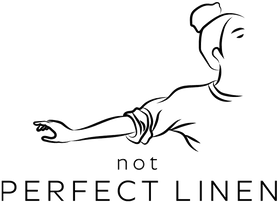Linen has a calm, enduring nature. It comes from flax—a temperate-climate crop with strong fibres—and when you care for it well, it lasts for years. This guide looks at the entire journey from field to wardrobe so you can decide how linen fits your values and your everyday linen clothing.
At notPERFECTLINEN, we work with European flax linen and design garments for long wear, repair, and reuse. For wash steps, see our Linen Care Hub; here we stay focused on sustainability.
Snapshot: the Linen Lifecycle
Farm → Fibre → Fabric → Use → End of life
Farm
Flax grows well in cooler European regions and is often rain-fed. In good farming practices, flax rotates with other crops (crop rotation, cover cropping) to improve soil health and biodiversity—an eco-friendly foundation.
Fibre & Fabric
After retting and scutching, fibres are spun and woven/knitted. Impacts depend on a mill’s energy, water treatment, and dyes—choices made all along the supply chain.
Use
Most lifetime impact comes from laundry. Cool water, air drying or tumble dry low, and wearing pieces longer reduce CO₂.
End of Life
Pure, minimally finished linen is easy to repair and, when it’s time, to repurpose or compost.

From Field to Fabric: the Linen Production Process
If you’re curious about linen production, here’s the short version:
- Growing flax: European farms sow flax in rotation with grains and legumes. These rotations protect soil, reduce pests, and lower input needs.
- Retting: After harvest, stems are laid in fields for dew retting (or processed with water), which loosens fibres from the woody core.
- Scutching & hackling: Mechanical steps separate and comb fibres into long, lustrous bundles.
- Spinning & weaving/knitting: Mills spin yarn, then create fabric. Energy mix and water treatment at this stage shape much of the footprint.
- Dyeing & finishing: Responsible chemistry and effluent control matter here. Simple finishes often preserve linen’s natural texture and durability—ideal for everyday linen clothing like shirts, dresses, and trousers.
Land & Water (What the Farm Stage Looks Like)
- Where it grows: Flax thrives in Western/Northern Europe’s mild, moist climate, which helps limit irrigation.
- Management practices: Rotations, careful nutrient use, and organic farming methods can reduce environmental impacts and build healthier soils.
- Whole-plant value: Fibre, shives, and seed each have uses, improving overall efficiency of the crop.

Linen vs. Polyester (A Fair Comparison)
Polyester is a synthetic fibre made from petrochemicals. It’s durable and inexpensive at scale, but it’s non-renewable, non-biodegradable, and sheds microfibres in the wash. Production is energy-intensive, and true closed-loop recycling is still limited.
Linen is plant-based and renewable. When mills manage water and chemistry responsibly—and when you choose low-energy care—linen garments typically carry a smaller long-term footprint. If you’re choosing between a pure polyester piece and a well-made linen garment you’ll wear often and mend as needed, linen is usually the lower-impact option over time.
CO₂ in Plain Language
- Farm: Flax absorbs CO₂ as it grows; rotations help soils store more carbon.
- Mill: Spinning, weaving, and finishing use electricity and heat; a cleaner grid lowers emissions.
- Use phase: Your routine matters most—cool water, mild detergent, air dry or low heat—plus wearing items longer. That’s where linen clothing shines.
Certifications & What They Mean
- OEKO-TEX® Standard 100: tests finished fabric for harmful substances.
- GOTS (Global Organic Textile Standard): relevant when a product uses certified organic fibres (e.g., organic linen or organic cotton blends) and responsible processing.
- European Flax®: indicates fibre origin from European flax.
NPL in Practice (Our Sustainability Steps)
We keep our choices practical and transparent:
- Materials & energy: We source European flax linen that is OEKO-TEX® Standard 100 certified and produced entirely in Europe—from fields to fabric. Our fabric partner uses 100% green energy for weaving, softening, and dyeing.
- Low-waste logistics: We hardly use plastic in the studio; we roll fabric on reusable carton tubes and keep re-using them for new yardage.
- Circular thinking: We divert fabric scraps to makers who turn them into wallets, shopping bags, and even clothes.
- Community: As proud @nplcares founders, we create ways for less-privileged people to engage with sustainable fashion.
- Packaging: Orders ship in 90% recyclable bags or cardboard boxes with paper tape. We minimise paper by emailing invoices on request, and our packaging is designed for easy return-reuse.
- Responsible sourcing: We choose suppliers who meet our social and environmental criteria and share our commitment to fairness and transparency.

What to Look For When You Shop Linen Clothing
- Clear origin (e.g., European flax linen) and a transparent supply chain.
- Health/safety labels: OEKO-TEX® Standard 100; GOTS when organic fibre applies.
- Construction that invites repair: sturdy seams, spare buttons, and accessible hems.
- Honest care on the care label: machine washable, low heat, option to steam/iron.
FAQs
Is linen environmentally friendly?
Yes—especially when the fibre comes from European flax, mills handle water and chemistry responsibly, and you care for garments at low energy. Longevity and repairability are the big wins.
How does linen compare to polyester?
Polyester is fossil-based and sheds microfibres; it isn’t biodegradable. Linen is plant-based, long-wearing, and can biodegrade when minimally finished—so the impact is usually lower over a long life.
What is the linen production process in one minute?
Grow flax in rotation → ret → scutch & hackle → spin → weave/knit → dye & finish. Responsible decisions at each step keep the footprint low and preserve durability for linen clothing.
Does linen need lots of water to grow?
In European regions, flax is typically rain-fed. Rotations and careful nutrient management help keep soils healthy.
How can I lower linen’s footprint at home?
Wash on cool water with a mild detergent, air dry or tumble dry low, and repair small issues early. Wearing garments for many seasons is the biggest climate win.


